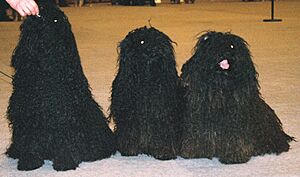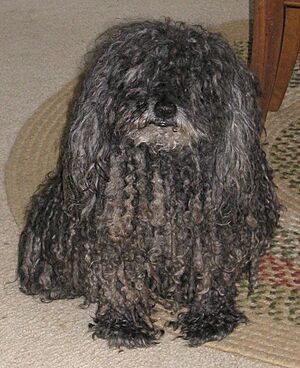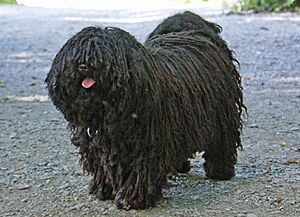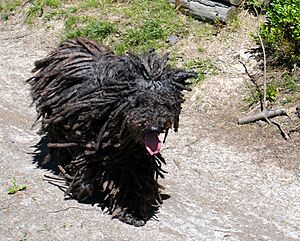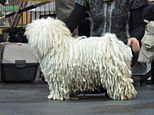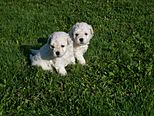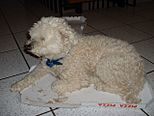Puli facts for kids
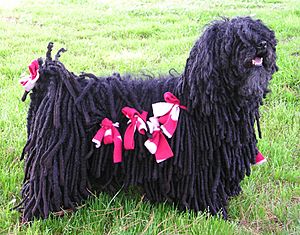
Puli
|
||||||||||||||||||||||||||
| Other names | Hungarian Puli | |||||||||||||||||||||||||
|---|---|---|---|---|---|---|---|---|---|---|---|---|---|---|---|---|---|---|---|---|---|---|---|---|---|---|
| Origin | Hungary | |||||||||||||||||||||||||
|
||||||||||||||||||||||||||
| Domestic dog (Canis lupus familiaris) | ||||||||||||||||||||||||||
The Puli is a small to medium-sized dog breed from Hungary. It is famous for its unique, long, corded coat. This coat looks a lot like dreadlocks. Another Hungarian dog, the Komondor, looks similar but is much bigger.
When you talk about a group of Puli dogs, you call them Pulik.
Contents
About the Puli Dog
What a Puli Looks Like
Pulis are usually solid black. But you can also find them in white, gray, or cream colors. Some cream-colored Pulis have a black mask on their face. White Pulis are not albino and have dark eyes and noses.
Female Pulis are about 16.5 inches (42 cm) tall at the shoulder. Males are a bit taller, around 17 inches (43 cm). Females weigh about 23-25 pounds. Males are usually a little heavier.
The Puli's coat is special because it forms cords. These cords are like thin ropes. They need a lot of care to stay clean and neat. As the dog gets older, the cords can grow very long, sometimes even touching the ground! Some owners choose to trim the coat short for easier care. Pulis hardly shed any hair.
Puli Personality
The Puli is a very smart and energetic dog. They need obedience training when they are young. If a Puli gets enough exercise, it can live in a city. However, they are happiest when they have a yard to play in.
Pulis that stay indoors need lots of activity to use up their energy. If they don't get enough exercise, they might become shy or too hyper. They need to run, hike, or jog. A simple walk around the block is often not enough for them. Pulis are usually cozy and friendly, especially with children. They are also sensitive dogs.
Activities and Training
Pulis are intelligent and quick dogs. Even with their thick coats, they are very fast and agile. They can change direction easily. They are also obedient enough to be trained for dog sports. Pulis form strong bonds with their owners.
Because they are so smart, Pulis do well in obedience training. It's best to start this training early. Pulis were traditionally used as herding dogs. They also sometimes guarded livestock. They make good guard dogs because they protect their family and home. Pulis are sensitive, fun-loving, and brave. But they can also be stubborn.
They are loyal to their owners but careful around strangers. Pulis stay active and playful, even when they are old. They need lots of exercise and space, ideally outdoors. They can be trained well. However, Pulis are generally not the best pets for city apartments. If they are stuck in small spaces for too long, they can become restless. This might make them hyper or lazy.
As working dogs, Pulis are very focused when they have a job. Some Pulis even work as police dogs. When guarding livestock, they protect their territory fiercely. Even though they are not huge, they will bravely try to scare away any intruders. They rarely cause serious harm.
As family dogs, Pulis are good security dogs and loyal guardians. They can be very friendly and playful. They see their family as their "flock" to protect. They will keep their distance from strangers until they are sure there is no threat. If they feel annoyed, they might attack without warning. So, strangers should be careful. Pulis can be very independent. They usually only listen to strong-willed owners.
Pulis can compete in many dog sports. These include dog agility trials, obedience, Rally obedience, showmanship, flyball, tracking, and herding events.
Pulis are known for their energy and determination. This comes from their history as sheepdogs. Every Puli is a natural shepherd. They instinctively know how to herd animals, even if they've never been trained. It's a good idea to start training a Puli when it's young. They are very independent and can be hard to train as adults.
Puli History
The Puli is a sheepdog that came from Hungary. People believe they arrived with the migration of the Magyars over 1,000 years ago. These people came from Central Asia. Pulis were used for both herding and guarding farm animals.
Pulis often worked with the much larger, white Komondor dog. Komondors are also a Hungarian breed. They are large, strong dogs, about 30 inches (76 cm) tall. Komondors mostly guarded the sheep or cattle at night. The Puli would herd and guard them during the day.
If wolves or bears attacked the animals, the Puli would alert the Komondors. Then the Komondors would come and fight the attackers. Pulis are good at fighting off wolves because their thick coat protects them from bites. Komondors usually rested during the day. At night, they walked around the flock, always patrolling.
Nomadic shepherds on the Hungarian plains really valued their herding dogs. They would sometimes pay as much as a year's salary for a Puli!
Around the early 1900s, the Puli breed became popular again. But they were not used as much for herding anymore. Large-scale shepherding was replaced by modern farming. So, the Puli's job changed. They started to become house dogs. After World War II, the breed became less popular as pets. Even today, they haven't gotten back the popularity they once had.
In 1935, the United States Department of Agriculture brought four purebred Pulik to Maryland. They wanted to study herding dogs. Researchers tested the Pulik's intelligence. The Pulik dogs scored very high, much higher than other herding breeds. When World War II started, these Pulik dogs were sold to dog breeders. It is thought that these four dogs are the ancestors of most Pulis in the United States today.
Puli Pictures
- White and black Pulik
See also
 In Spanish: Puli para niños
In Spanish: Puli para niños


